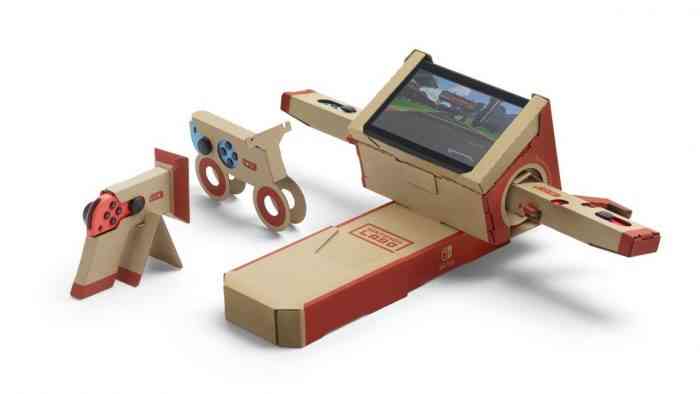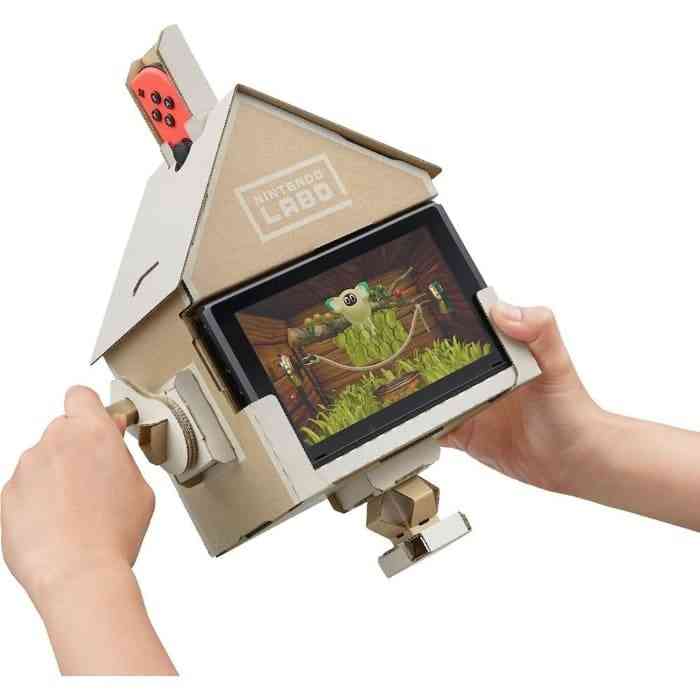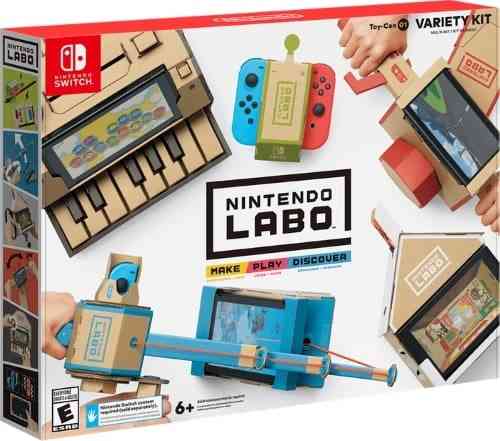Nintendo LABO Variety Kit Review
Of all the pizza boxes, Kraft dinner boxes, and other assorted pieces of cardboard I’ve sent to the recycle bin, I never once thought “hey, this would be fun to play with”. The obvious exception to this are those big, cardboard refrigerator boxes that are perfect for making a secret base out of. Why am I talking about cardboard on a video game website? Well, allow me to introduce you to Nintendo’s latest innovation, the Nintendo LABO, a series of cardboard creations that you’ll build and play games with via the Nintendo Switch for some unique experiences. For this Nintendo LABO review, we’ll be looking at the Nintendo LABO Variety Kit. Perfect for aspiring bikers, fishermen, and pianists. I said pianists, stop giggling.
When you crack open the Nintendo LABO Variety Kit, you’ll first see the game cartridge that you’ll need to boot up in the Switch to get started. The Variety Kit doesn’t include any instructions on paper, and good luck trying to build any of these without instructions. The instructions are incredibly well detailed on the Switch screen which you can control via the Joycon or touchscreen – but obviously, the Joycon is much better. I often found when I touched the screen to move the instruction images around for a better angle, I’d accidentally knock the screen down. That one little kickstand just does not do the trick – but that’s a Switch problem, not a LABO problem. When you’re ready to get started, you’ll first build a test project – a holder for one of the Joycons. Once the test project is out of the way, what you choose next is 100% up to you, but I personally did them all in order. Contained within the Variety Kit is an RC Car, Fishing Rod, House, Motorbike, and Piano – each one a little bit more complex than the last.

The RC Car is a dud. Once built it uses the vibrations from the two Joycons to “propel” itself with the Switch screen acting as a remote control. It works, but it moves at such a slow pace that makes it a bit lame. Next up was the Fishing Rod. The Fishing Rod is one of the highlights from the Variety Kit. It looks cool, the rod is actually telescopic, and it does a great job of creating the illusion of fishing. The actual fishing mini-game contained within is pretty cool as well. Of course, it’s just a mini-game, so the amount you can actually do is quite limited to dropping your lure to the bottom of the ocean and back up again. There’s a variety of different fish to, well, fish, but after you’ve caught enough of them, you’ll be clamoring to move on to the next project.
Failed Home Renos
The next project is the House. The House project is yet another dud. Once built, you’ll have three different “buttons” that you can insert on the left, right and bottom of the house which creates different environments for the odd little creature living inside. The design of the house is where this project gets flawed. Because there’s a bottom hole to put buttons in, you’re forced to lift the house up and then set the house flat on its back. It just doesn’t make sense – why not put a button on the roof so the house doesn’t have to be moved around. And without any real directions, the effects of the buttons and the position of the house is all trial and error – and none of it is really that engaging.
The fourth project, another highlight from the Variety Kit, is the Motorbike. Here you’ll create the front end of a motorbike, with an actual, twistable accelerator. There are two mini-games included for Motorbike, a circuit like race and a stadium. The circuit includes a few different difficulties and you’ll race around a track against computer-controlled racers. If you’re feeling creative, you can even design your own course. Then there is the stadium, where you compete against computer-controlled racers to collect the most balloons during a time limit. This mode includes a bunch of ramps and jumps, which alone is cool, but add in the fact that you can actually scan an object into the middle of the stadium for unique terrain is just amazing. My kids and I were scanning all sorts of objects, such as our hands, stuffies and even the babies face! Scanning was easy enough and it converts the scanned object into bumps on the grassy field creating new jumps and grooves to drive in and around. If Nintendo is smart, they’ll incorporate this ability into future games.
Let’s Play Chopsticks!
The final project was the most daunting, especially when the game advised me it could take over three hours to complete – but by now I was a LABO pro and I completed the Piano in 90 minutes (feel free to contact Guinness Book of World Records and let them know). Once created, I had a fully functional piano that plays a full octave of notes. Included with it was a switch that alters the octaves and four different insertable pieces that changes the pianos sounds from a traditional piano sound to meowing cats and old people trying to hit a note (yes, it’s as odd as it sounds, and very amusing). While I’m sure some really musically inclined gamers will be able to make some beautiful music with the LABO Piano, I was bored after hitting the notes for a half hour. I was also a bit disappointed with the design of the Piano, as the keys aren’t very firmly in place, so any excessive jostling will cause the keys to be dislodged. The bottom of the Piano also seems to pop open when lifted up.

Each project wasn’t too difficult to put together, some just took longer than others. I did find myself getting a bit fatigued by the end of my LABO review time. Had I been playing with the LABO on my own terms, I would have opted to just do a different project each weekend – but due to the nature of reviews, I had to rush to get everything built as soon as possible. Each project has at least one mini-game included, but most of the mini-games are only worth a short amount of your time. None of them have much in the way of last quality. One of the coolest parts of each project is the ability to see some of the behind-the-scenes stuff in the LABO “Discover” section. You’ll be able to see how the Switch and the Joycons are interacting with the cardboard creations to accomplish various things.
Building each project in the Nintendo LABO Variety Kit was, for the most part, really fun and satisfying. Often I would be putting something together with no idea how it would factor in, but when I finally figured out how it tied into the final product, I would get this Eureka! moment that always brought a smile to my face. I tried to get my kids (3 and 7) to participate in building, but they weren’t very interested – and both of them are very much into crafts. I think the restrictiveness of having to follow the directions was a bit of a turn-off for them. They did, however, love trying out each project once they were built. Each project will take you between one to three hours to complete and then you’ll play a mini-game once or twice before you lose interest. There are a few “experimental” things you can try to build and design via the “Secret Garage”, but none of it really seemed interesting enough for me to bother with. The Nintendo LABO Variety Kit has some fun and satisfying aspects to it, but it lacks any real longevity. And now I’m faced with the ultimate dilemma – where the heck will I store all these cardboard projects now?
***The Nintendo LABO Variety Kit was provided by the publisher***
The Good
- Six different projects
- Fishing Rod and Motorbike are fun projects
The Bad
- Mini-games won’t satisfy for very long
- Where do I store this cardboard now

